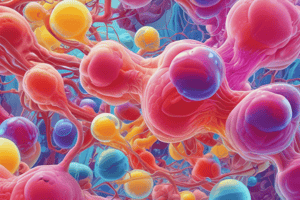Podcast
Questions and Answers
What is the primary effect of angiotensin II in the body's physiological responses?
What is the primary effect of angiotensin II in the body's physiological responses?
- Promotes vasodilation to reduce blood pressure
- Decreases the retention of water in the kidneys
- Inhibits the release of AVP
- Stimulates aldosterone secretion for sodium retention (correct)
In the context of compensatory mechanisms, which factor primarily triggers the release of AVP?
In the context of compensatory mechanisms, which factor primarily triggers the release of AVP?
- Increased plasma osmolality detected by osmoreceptors (correct)
- High blood pressure due to fluid overload
- Decreased sodium concentration in the blood
- Elevation of aldosterone levels
How do diuretics like furosemide affect fluid balance in the body?
How do diuretics like furosemide affect fluid balance in the body?
- They enhance sodium excretion to reduce fluid overload (correct)
- They decrease fluid output without affecting sodium levels
- They stimulate the release of aldosterone
- They promote sodium retention to increase blood volume
What role does aldosterone play in the regulation of sodium balance?
What role does aldosterone play in the regulation of sodium balance?
Which condition is characterized by the body retaining sodium and water despite a reduced effective circulating volume?
Which condition is characterized by the body retaining sodium and water despite a reduced effective circulating volume?
What function does Atrial Natriuretic Peptide (ANP) serve in relation to the RAAS?
What function does Atrial Natriuretic Peptide (ANP) serve in relation to the RAAS?
What is the primary pathway of fluid retention during a haemorrhagic state?
What is the primary pathway of fluid retention during a haemorrhagic state?
What is the initial trigger for the activation of the Renin-Angiotensin-Aldosterone System (RAAS)?
What is the initial trigger for the activation of the Renin-Angiotensin-Aldosterone System (RAAS)?
What is the primary role of osmolality in the body?
What is the primary role of osmolality in the body?
Which of the following best describes effective circulating volume (ECV)?
Which of the following best describes effective circulating volume (ECV)?
How does excess sodium affect extracellular fluid volume?
How does excess sodium affect extracellular fluid volume?
What is one physiological implication of volume contraction?
What is one physiological implication of volume contraction?
Which hormone is primarily responsible for sodium balance regulation?
Which hormone is primarily responsible for sodium balance regulation?
In congestive heart failure, which of the following occurs despite increased extracellular fluid volume?
In congestive heart failure, which of the following occurs despite increased extracellular fluid volume?
What mechanism does the body primarily use to regulate osmolality?
What mechanism does the body primarily use to regulate osmolality?
Which of the following factors can lead to a discrepancy between extracellular fluid volume and effective circulating volume?
Which of the following factors can lead to a discrepancy between extracellular fluid volume and effective circulating volume?
What is the primary reason for decreased effective circulating volume (ECV) in congestive heart failure despite fluid overload?
What is the primary reason for decreased effective circulating volume (ECV) in congestive heart failure despite fluid overload?
Which physiological condition is indicated by hyponatremia?
Which physiological condition is indicated by hyponatremia?
In nephrotic syndrome, edema primarily results from which of the following?
In nephrotic syndrome, edema primarily results from which of the following?
What is the relationship between effective circulating volume and tissue perfusion?
What is the relationship between effective circulating volume and tissue perfusion?
What role do RAAS, AVP, and ANP play in body fluid regulation?
What role do RAAS, AVP, and ANP play in body fluid regulation?
What does a high sodium concentration generally indicate?
What does a high sodium concentration generally indicate?
Why may sodium retention exacerbate conditions such as hepatic cirrhosis and nephrotic syndrome?
Why may sodium retention exacerbate conditions such as hepatic cirrhosis and nephrotic syndrome?
Which investigation is used to assess kidney performance in maintaining sodium and water balance?
Which investigation is used to assess kidney performance in maintaining sodium and water balance?
Flashcards
Effective Circulating Volume (ECV)
Effective Circulating Volume (ECV)
The portion of extracellular fluid (ECF) that effectively perfuses tissues within the vascular system.
Osmolality
Osmolality
The concentration of solutes in body fluids, primarily determined by sodium. It's crucial for maintaining cell function, especially in the central nervous system (CNS).
Sodium Balance
Sodium Balance
The process of maintaining a balance of sodium in the body, which directly affects extracellular fluid (ECF) volume.
Renin-Angiotensin-Aldosterone System (RAAS)
Renin-Angiotensin-Aldosterone System (RAAS)
The renin-angiotensin-aldosterone system (RAAS) is a hormonal system that regulates blood pressure and fluid balance. RAAS is activated when there is low blood pressure or low fluid volume. It causes the release of renin from the kidneys, leading to the production of angiotensin II which constricts blood vessels and increases sodium and water reabsorption in the kidneys.
Signup and view all the flashcards
Atrial Natriuretic Peptide (ANP)
Atrial Natriuretic Peptide (ANP)
A hormone produced by the heart that primarily counteracts RAAS, promoting sodium and water excretion and lowering blood pressure.
Signup and view all the flashcards
Arginine Vasopressin (AVP)
Arginine Vasopressin (AVP)
A hormone released by the pituitary gland that helps regulate blood pressure by increasing water reabsorption in the kidneys, thus increasing blood volume.
Signup and view all the flashcards
Volume Expansion
Volume Expansion
A condition where the body has too much fluid, often leading to swelling (edema).
Signup and view all the flashcards
Volume Contraction
Volume Contraction
A condition where the body has too little fluid which can lead to dehydration and low blood pressure.
Signup and view all the flashcards
Antidiuretic hormone (ADH) or Vasopressin
Antidiuretic hormone (ADH) or Vasopressin
A hormone that regulates water reabsorption in the kidneys, helping maintain blood volume and pressure.
Signup and view all the flashcards
Angiotensin-Converting Enzyme (ACE)
Angiotensin-Converting Enzyme (ACE)
A key enzyme in the RAAS that converts angiotensin I to angiotensin II, a potent vasoconstrictor.
Signup and view all the flashcards
Aldosterone
Aldosterone
A hormone that increases sodium reabsorption in the distal nephron and collecting duct, leading to water retention and increased blood volume.
Signup and view all the flashcards
Fluid overload in liver cirrhosis
Fluid overload in liver cirrhosis
A state where the body retains sodium and water despite reduced effective circulating volume, leading to fluid accumulation in the abdomen and systemic edema.
Signup and view all the flashcards
Low osmolality
Low osmolality
A state where the body retains water rather than sodium, often caused by factors like excessive water intake or kidney dysfunction.
Signup and view all the flashcards
Diuretics
Diuretics
A medication that increases sodium excretion, helping to reduce fluid overload and lower blood pressure.
Signup and view all the flashcards
Congestive Heart Failure (CHF) and Cirrhosis: ECV Paradox
Congestive Heart Failure (CHF) and Cirrhosis: ECV Paradox
Reduced effective circulating volume (ECV) despite fluid overload, leading to edema and sodium retention. Common in patients with CHF and cirrhosis.
Signup and view all the flashcards
Nephrotic Syndrome: Fluid Shift and Retention
Nephrotic Syndrome: Fluid Shift and Retention
Marked by proteinuria, hypoalbuminemia, and edema due to fluid shifting into the interstitial space. Sodium retention worsens the condition.
Signup and view all the flashcards
Plasma Osmolality: Water Balance Indicator
Plasma Osmolality: Water Balance Indicator
Determines water balance and reflects sodium concentration. Decreased osmolality indicates hyponatremia, often a sign of water retention.
Signup and view all the flashcards
Sodium Concentration: More About Water?
Sodium Concentration: More About Water?
Low sodium concentration typically indicates water imbalance rather than sodium imbalance. Elevated sodium can signal dehydration or hypernatremia.
Signup and view all the flashcards
Renal Function Tests: Sodium and Water Balance
Renal Function Tests: Sodium and Water Balance
Assess kidney functionality in maintaining sodium and water balance. Abnormal results suggest impaired sodium excretion, leading to fluid retention.
Signup and view all the flashcards
Hormonal Regulators: RAAS, AVP, and ANP
Hormonal Regulators: RAAS, AVP, and ANP
RAAS, AVP, and ANP are critical for regulating sodium and water balance. They ensure proper blood pressure and fluid homeostasis.
Signup and view all the flashcards
Volume Expansion's Impact on AVP Regulation
Volume Expansion's Impact on AVP Regulation
Chronic volume expansion can shift the set point and reduce the sensitivity of osmoreceptors, leading to delayed AVP release.
Signup and view all the flashcards
ECV Reduction in CHF and Cirrhosis
ECV Reduction in CHF and Cirrhosis
Reduced effective circulating volume (ECV) in heart failure and cirrhosis is due to poor vascular perfusion despite increased total body fluid.
Signup and view all the flashcardsStudy Notes
Extracellular Fluid Volume and Sodium Balance
- Extracellular fluid (ECF) volume and sodium balance are crucial for maintaining blood pressure, cardiac output, and tissue perfusion.
- Effective circulating volume (ECV) is the portion of ECF perfusing tissues. It differs from total ECF volume.
- ECV often varies inversely with ECF volume in certain conditions.
- Osmolality is the concentration of solutes in body fluids, mainly determined by sodium. It's vital for cell function, especially in the central nervous system.
- Sodium balance regulates ECF volume without impacting osmolality.
- Increased sodium leads to volume expansion (edema), while sodium loss results in volume contraction.
Key Concepts & Definitions
- ECF includes blood plasma and interstitial fluid, affecting vascular volume, blood pressure, and cardiac output.
- ECV represents the part of ECF within the blood vessels effectively perfusing tissues.
- Osmolality is the concentration of solutes in body fluids, primarily determined by sodium levels.
- Sodium balance carefully regulates extracellular fluid volume without interfering with osmolality.
Learning Objectives
- Differentiate between extracellular fluid volume and effective circulating volume.
- Understand how the body regulates extracellular fluid volume and osmolality.
- Explain the role of the renin-angiotensin-aldosterone system (RAAS), atrial natriuretic peptides (ANP), and arginine vasopressin (AVP) in regulating extracellular fluid volume.
- Differentiate between osmotic and hemodynamic control of arginine vasopressin (AVP) secretion.
- Understand the role of the kidneys in regulating sodium excretion and extracellular fluid volume.
Clinical Applications
- Congestive heart failure involves fluid accumulation in tissues (edema) despite increased extracellular fluid volume (ECF) but decreased effective circulating volume (ECV).
- Low osmolality may indicate water retention, not necessarily sodium imbalance.
- Diuretics like furosemide increase sodium excretion and reduce fluid overload.
- ACE inhibitors reduce sodium retention and blood pressure, restoring fluid balance.
- Liver cirrhosis results in sodium and water retention despite reduced effective circulating volume, causing ascites (abdomen swelling) and systemic edema.
Pathophysiology
- Renin-Angiotensin-Aldosterone System (RAAS): Activated when blood pressure or sodium delivery to kidneys decreases. RAAS leads to vasoconstriction, aldosterone secretion (sodium and water retention), and increased vasopressin production.
- Osmotic and Hemodynamic Control of AVP: AVP release is primarily triggered by increased plasma osmolality, detected by osmoreceptors. Significant drop in blood volume also stimulates AVP release.
- AVP prioritizes blood volume over osmolality during severe blood loss or low blood volume; thus, water retention is crucial over sodium regulation.
Investigations
- Plasma osmolality measurement assesses water balance. Low osmolality indicates water retention (hyponatremia).
- Sodium concentration measurements help determine water balance, not necessarily sodium imbalance (in some cases sodium is high).
- Renal function tests evaluate the kidney's capacity to maintain sodium and water balance. Abnormalities indicate issues with sodium excretion.
Studying That Suits You
Use AI to generate personalized quizzes and flashcards to suit your learning preferences.




